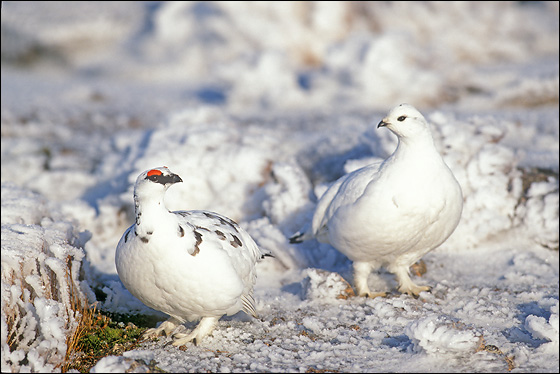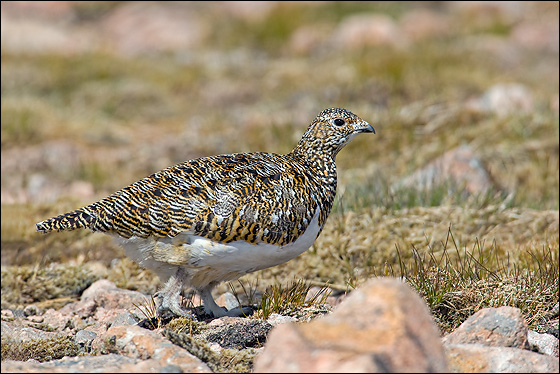Ptarmigan (Lagopus muta)
Only the toughest birds survive at 83°N, the northern limit of the Ptarmigan’s range (in Greenland). And indeed, the Ptarmigan is like some madcap Arctic adventurer. It is positively drawn to snowdrifts, cold open areas with very low vegetation, rocky places buffeted by powerful and freezing winds, and high altitudes. It lives there and breeds there, remaining to winter in areas where it would seem impossible for anything to survive. And yet there is little competition in such places for those that can beat the elements, and even the predators are sparsely distributed.
One might say that the Ptarmigan wraps up well for its environment. It has thick plumage, especially in winter, and this covering even extends to the legs and feet, to prevent heat loss through them. Even the nostrils are feathered. Moreover, the Ptarmigan’s outward appearance closely follows the seasons. In winter, when its surroundings are white, so the Ptarmigan is completely white, too, except for the jet black sides of its tail, a delicate red ring over its black eye and a small ink spot behind its bill (the last-named in the male only). In spring, when the snow begins to melt and become patchy, the Ptarmigan becomes brown and blotchy-white itself, and seeks out snow-drifts to roost; and in autumn, when the tundra colour begins to fade, the Ptarmigan’s main colour becomes greyer. In order to retain its identity, though, the wings and lower belly remain white throughout the year.
Ptarmigans feed on the ground, and their rations can appear extraordinarily meagre at times. In winter, for example, they sometimes eat only twigs and buds from willows and birches, for months on end. The tedium is relieved in spring, with the emergence of shoots and other green parts of plants, and for a brief period in autumn there is a feast of berries to be had. But usually there isn’t much variety or goodness. The guts of grouse generally are large and long, enabling the birds to cope with what is a nutritionally poor diet. Ptarmigans find most of it by scratching in the snow with their feet. In winter they grow special toenails twice their normal length to help this process along. What with feathered feet and long nails, they are virtually fitted with their own snowshoes.
In March and April Ptarmigans in their winter flocks split up and form their own territories. The males advertise their patch with a curious call, sounding like running a stick over the slats of a picket fence, or like a long retching belch. The nature of the pair bond seems to vary from place to place: in some areas, birds are monogamous, in others the males are polygynous (several female mates), and in Iceland there is evidence that both sexes may have rather casual, short-term pair-bonds (promiscuity). Whatever the nature of the relationship it invariably splits up before the eggs hatch, and the young are tended only by the female.
From ‘Birds: A Complete Guide to All British and European Species’, by Dominic Couzens. Published by Collins and reproduced with permission.


